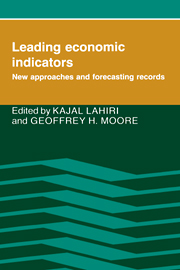Book contents
- Frontmatter
- Contents
- Preface
- List of contributors
- 1 Introduction
- PART I NEW CONCEPTS AND METHODS
- 2 Toward a theory of leading indicators
- 3 A time-series framework for the study of leading indicators
- 4 A probability model of the coincident economic indicators
- 5 An international application of Neftci's probability approach for signaling growth recessions and recoveries using turning point indicators
- 6 On predicting the stage of the business cycle
- 7 Bayesian methods for forecasting turning points in economic time-series: Sensitivity of forecasts to asymmetry of loss structures
- 8 New developments in leading indicators
- PART II FORECASTING RECORDS AND METHODS OF EVALUATION
- PART III NEW ECONOMIC INDICATORS
- Index
3 - A time-series framework for the study of leading indicators
Published online by Cambridge University Press: 05 June 2012
- Frontmatter
- Contents
- Preface
- List of contributors
- 1 Introduction
- PART I NEW CONCEPTS AND METHODS
- 2 Toward a theory of leading indicators
- 3 A time-series framework for the study of leading indicators
- 4 A probability model of the coincident economic indicators
- 5 An international application of Neftci's probability approach for signaling growth recessions and recoveries using turning point indicators
- 6 On predicting the stage of the business cycle
- 7 Bayesian methods for forecasting turning points in economic time-series: Sensitivity of forecasts to asymmetry of loss structures
- 8 New developments in leading indicators
- PART II FORECASTING RECORDS AND METHODS OF EVALUATION
- PART III NEW ECONOMIC INDICATORS
- Index
Summary
From the point of view of a time-series analyst there are two questions of interest that concern the methodology dealing with the use of leading and coincident indicators. The first is the “surprising” longevity of the approach while competing methodologies such as large-scale econometric models or time-series representations have been subject to a fair amount of criticism over the years. This issue, we shall see, can be disposed of easily. It is the second question that is more substantial. Is the main contribution of the leading indicators approach to forecasting business cycle turning points one of convenience, or is it that the leading indicators capture an aspect of turning point prediction that econometric models or time-series representations miss?
Why is it not surprising that the methodology of leading indicators seems to have been subject to less controversy than the econometric models or time-series representations? Mainly because the latter two approaches impose explicit restrictions on observed phenomena and hence subject themselves to productive criticism and improvement. The approach of leading indicators, on the other hand, imposes few, if any, restrictions on the reality and is more robust. But it also generates less controversy and leads to fewer advances in understanding economic phenomena.
These comments notwithstanding, it is possible that the methodology of leading indicators captures an aspect of real phenomena that econometric models or time-series representations miss. This chapter deals with this question and shows under what conditions the approach has some special raison d'être.
- Type
- Chapter
- Information
- Leading Economic IndicatorsNew Approaches and Forecasting Records, pp. 57 - 62Publisher: Cambridge University PressPrint publication year: 1991
- 4
- Cited by



